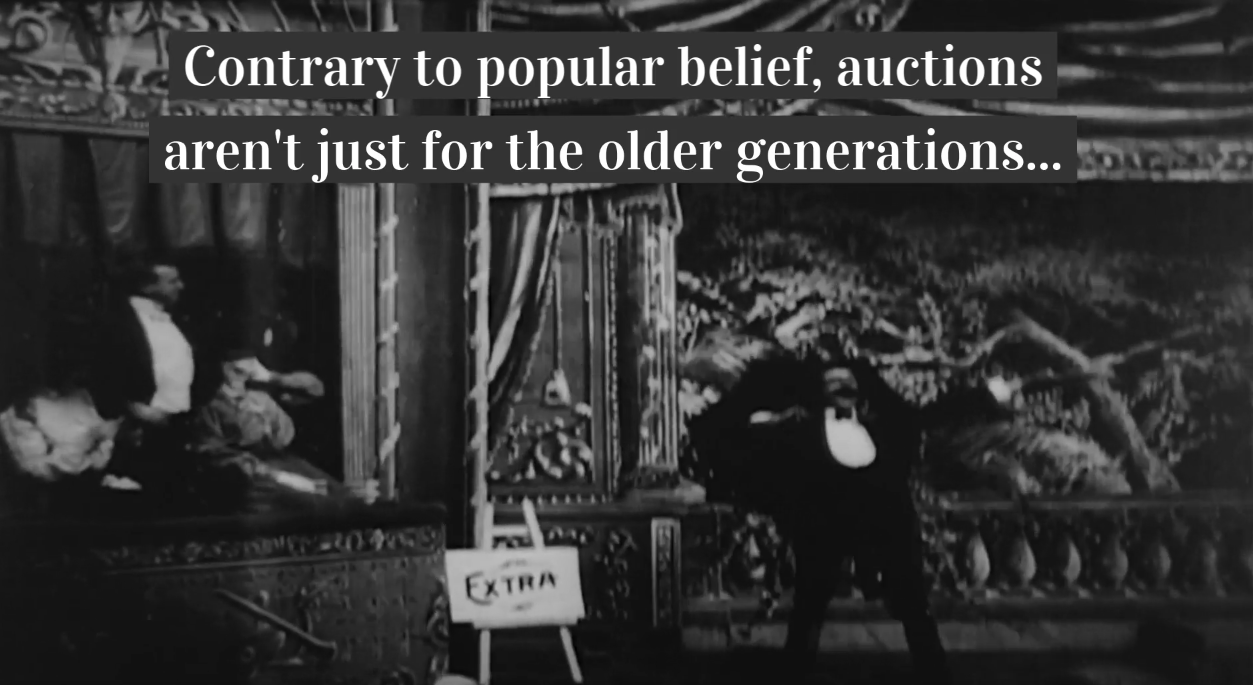How Do Auctions Work?
When it comes to auctions, the general public has a basic idea of how they work thanks to TV or movies. Essentially, a lot of people sit in a room while a fast-talking man spits out numbers and points to people around the room.
After an undetermined amount of time, he bangs his gavel and says something like, “Sold! To the woman with the pet peacock!” or some nonsense like that.
There have been famous auction movie scenes in movies, such as bidding for a golden ticket in the original Willy Wonka & the Chocolate Factory to the opening scene of Phantom of the Opera.
While we take everything in Hollywood with a grain of salt, are these scenes accurate depictions of how auctions work? Are people really raising auction cards? Is there a fast-talking man there? How do people understand him?
Let’s pull back the curtain and talk about how auctions really work.
What is an Auction?
It doesn’t take an art expert to figure this out, but an auction is the act of buying and selling goods through the process of bidding.
If you’ve ever bought something on eBay, that’s a great depiction of the basics of an auction. An item comes up for sale and people begin bidding on such items. In order to be the top bidder, you must bid higher than the previous person.
Eventually, the auction comes to an end and the highest bidder will get to take home the item.
Auctions exist for virtually any item you can think of - houses, cars, and in our case, jewelry, antiques, fine art, furniture, decorative items, and much more.
The Auction Process
When it comes to an auction, there are actually plenty of steps that happen before everyone steps into a room to place their bids.
The Preview Period
Items are not a surprise for bidders: everyone knows what lots (aka items up for sale by auction) are going to be there and open for bidding.
That’s why bidders are allowed to check out the items ahead of time. They can look at an item’s condition, find out what the opening bid may be, and get a general sense of what will be there.
The preview period can take place the day before the auction, a few days before, or even in the hours leading up to the auction.
Once bidders have decided what items tickle their fancy, they must register with the auctioneer using a photo ID and other information.
Yes, that excludes the climatic scene of a random bidder crashing through the door to outbid everyone on a certain item.
The Start of the Auction
Just like anything else, auctions have a set time when they’re ready to begin.
In order to signify the start of an auction, the auctioneer introduces the terms and conditions of the auction. When everyone is ready the auctioneers will start the bidding with the first lot.
So do people just jump right in with a price? Not exactly.
It depends on the auction, but the opening price is set by the auctioneer with the approval of the seller. The auctioneer is not some random host but an experienced professional who has consulted valuation experts ahead of time.
They will set what they believe to be a reasonable opening price.
On eBay and other sites like it, the seller can set the price. This requires the seller to do their research on certain items. While they are obviously interested in selling their items for the highest price, they must make sure to set the opening bid at a reasonable amount in order to ensure people continuously bid.
The Actual Bidding
Alright, now we’re getting to the exciting part. Do people really hold up paddles with numbers?
In a live auction with a live audience, yes. After registration, bidders are registered and assigned a paddle number. By simply raising the paddle during the bidding process, they are submitting their bid for an item at the price the auctioneer is calling out.
The bidding is officially over when the auctioneer says “Sold!” and closes the bidding. The item is awarded to the highest bidder.
Is there Really a Fast Talking Guy?
It depends, usually for Fine Art and Antiques auctions the audience can come from all over the world so speaking clearly and slowly will allow all bidders to understand the auctioneer.
Auctioneers are trained professionals who have trained for such an event. Local auctions, agricultural auctions, storage auctions, and real estate auctions usually take place in person and not online so their bidders usually speak the same language as the auctioneer. In these cases, they can employ the auction ‘chants’ they have rehearsed. They aren’t talking fast (aka action chant or patter) for the sake of sounding cool (although they do sound pretty cool) but their speaking is a way to drive up bids.
If you listen carefully, many auctioneers have a certain cadence when they talk that’s a rhythmic, monotone voice that encourages people to take part in the action.
We encourage you to go check out a video of some auctioneers as they explain their craft and put it into action!
Has the internet had any effect on auctions?
The internet has had a big effect on auctions. Not only are places like eBay insanely popular, but many auction and art houses have brought an online audience to their auctions.
Now, instead of people raising cards they can bid electronically from the comfort of their own home.
We here at Gray’s have hosted virtual auctions in the past and encourage you to check out the next one when you can. You can bid via the telephone, our website, or even our app. You never know what piece you may find or something that tickles your fancy!
Stay informed about the exciting and ever-changing world of art and auctions - whether you’re a seasoned collector or just getting your feet wet. We curate & deliver the most essential & exciting art and auction news, once a week (in a way that won’t make you fall asleep.) Sign up via the form below!


